The Politics of Anti-Westernism in Asia: Visions of World Order in Pan-Islamic and Pan-Asian Thought, Cemil Aydin (New York: Columbia University Press, 2007), 320 pp., $32.50 cloth.
John M. Hobson (reviewer)
Working at the interstices of International Relations and International History, Cemil Aydin has produced an exceptionally detailed account of the rise and development of pan-Asian and pan-Islamic thought from the early nineteenth century through to World War II. The background theoretical hook might be summarized as a critique of Eurocentrism as well as (relatedly) Samuel Huntington's "clash of civilizations" approach. Aydin sets out to challenge popular assumptions that non-Western ideological movements are always hostile to Western values, on the one hand, and that such movements emerge as a function of either anticolonial struggles or conservative and religious reactions to global modernity, on the other. Rather, he reveals that these movements were often sympathetic to the West. And, crucially, when they did become critical they did so not in terms of rejecting Western values, but rather in terms of holding the West to account, on the grounds that its imperial and racist practices contradicted its earlier "progressive" universalist (Enlightenment) ideals.
The book's further objective is to identify the agency of non-Western actors in the shaping of world order. In this respect, its greatest service is that it brings to an English-speaking audience the many ideas that were produced by the key pan-Asian and pan-Islamic intellectuals. In doing so, it produces a very rich picture of what was occurring on the "other" side of the civilizational-imperial frontier during the nineteenth and early twentieth century.
The narrative is divided into a series of chapters, each of which deals with a key phase in the development of these ideologies. Following an introductory chapter, chapter two deals with the first phase, which unfolded roughly between 1840 and 1882. In this period, intellectuals within the Ottoman Empire and Japan saw Europe as a positive and progressive model for reform and emulation. Interestingly, they sought to copy Europe in terms of its economic and political institutions not so much to achieve military parity (the popular Eurocentric assumption), but rather as a means to become "civilized" so as to enter Eurocentric international society.
To this end the Tanzimat Proclamation of 1839 was a pivotal expression of the view that European civilization represented the highest stage of human progress and that cooperation with the West was the best way forward. Moreover, in further contrast to Eurocentric formulations and popular "clash of civilizations" thinking, rising Islamic solidarity emerged not as a reaction against Ottoman modernization but because of the rising prestige of the Ottoman caliphate. And such rising prestige was a function of its modernizing program. Following the Meiji Restoration, the Japanese situation more or less mirrored this picture. At this early stage, the assumption held by pan-Islamists and pan-Asianists was that colonialism and unequal treaties could be thrown off once modernization had been achieved. Thus, working with rather than against European states was deemed by these movements to be vital.
Chapter three focuses on the subsequent phase, which unfolded between 1882 and 1905. It was triggered by the emergence of scientific racism in the West, which in turn promoted the imperial scramble for Africa. The rise of scientific racism in the West marked a normative shift from Enlightenment universalism to a cultural relativism—that is, under Enlightenment thinking modernity was assumed to be a universal good that could be achieved by all societies (as in modernization theory), and was therefore potentially inclusive of non-Western societies. Scientific racism closed this door by pronouncing non-Western societies inherently inferior, uncivilized, and incapable of successful modernization. This destabilized the pan-Islamic and pan-Asian assumption that non-Western societies could join Eurocentric international society were they to work within the European model of civilization.
Aydin pays special attention to the intellectual debate between the well-known Orientalist French philosopher Ernest Renan and Jamal ad-Din al-Afghani, the founding father of Islamic modernism and an advocate of pan-Islamic unity. The latter responded to the former's critique of Islam as an ideology that has economically irrational credentials by pointing up the early liberal phase of Islam that had made the Middle East the center of the world by about 1000 CE. All in all, the reaction to Europe's racist turn saw the crafting of a new conception of Islamic civilization by pan-Islamists, one that was deemed to be different but not inferior to Western civilization. Key thinkers, such as Halil Halid, developed a critique of the West arguing that European imperialism and racist thinking constituted a moral double standard, insofar as they contradicted Europe's own self-professed universal progressive ideals.
Such a shift occurred more or less simultaneously in Japan, especially after the Sino-Japanese War of 1895. Kaiser Wilhelm's warning of a "yellow (Japanese) peril"—a phrase that quickly entered mainstream Western thinking—provoked Japanese intellectuals to respond in kind, with Konoe Atsumaro (in 1898) speaking of the "white peril" in East Asia. Konoe also inaugurated the idea of an Asian Monroe Doctrine so as to protect East Asia from continuing Western intervention.
Chapter four deals with the next phase, which began in 1905 as a result of the Japanese military victory over Russia that year. As is well known, this victory prompted an identity crisis of the West since it blew apart the myth of white Western racial and civilizational superiority. Aydin emphasizes this as a transformative moment in reconstituting world order. Not only did it add to growing Western civilizational anxiety, but it acted as a spur for Asian solidarity, linking up pan-Islamic and pan-Asian movements into one broad transnational movement. It also spurred Asian nationalists to search for power alliances through pan-Islamic and pan-Asian visions so as to counterbalance the perceived unity of the West. Significantly, the concept of Tôyô (East), which had hitherto been confined to Japan and China, was now extended to all of Asia. And after 1905, Asian states increasingly saw Japan rather than Europe as the successful model for economic and political reform.
Aydin's narrative highlights the gap between pan-Islamism and the Ottoman state and between pan-Asianism and the Japanese state. In the pre–World War I period, both states failed to embrace these ideologies for fear of alienating the European states. However, between 1913 and 1923 this changed as far as the Ottoman state was concerned after the Italian invasion of Libya in 1911, the subsequent lack of censure from European states, and the loss of Ottoman territory to the Balkan states on the eve of World War I, which was subsequently recognized at the London Peace Conference in 1913. Perceiving that European international society and international law were constructed in a way that served to block its progress, the Ottoman state embraced pan-Islamism in its realpolitik during World War I, siding with Germany in order to defeat the imperial powers.
Unfortunately, this is where the narrative presents certain difficulties for the reader. Although the detail in the book is extremely impressive, it not infrequently comes at the cost of clarity. For example, I am unclear as to why pan-Asianism and pan-Islamism receded during the 1920s other than through the possibility that "Eastern" radicalism was rechanneled into the nationalist movements. If so, then a discussion of the relationship between pan-Islamism/ pan-Asianism and the nationalist movements would have been necessary. Further, more attention to theoretical issues would almost certainly have helped the reader, clarifying the narrative and drawing out the wider implications. A more equal measure of the two disciplinary contributions might have helped considerably—that is, a bit more International Relations and a little less International History.
Despite these reservations, this is an extremely well-researched book, bursting with arguments and insights far too numerous to mention, let alone detail, in this short review, but all of which will be a boon for scholars who are interested in East-West relations.
—JOHN M. HOBSON
The reviewer is Professor of Politics and International Relations at the University of Sheffield. He is author of The Eastern Origins of Western Civilisation (2004), co-editor of Everyday Politics of the World Economy (2007), and is currently finishing a book on his great grandfather, the economist John A. Hobson.



